Coupled Analysis of Offshore Wind Turbine Jacket Structures with Pile-Soil-Structure Interaction Using FAST v8 and X-SEA
Abstract
1. Introduction
2. Coupled Analysis of Turbine and Support Structure
2.1. Brief Introduction of Offshore Structural Analysis Software X-SEA
2.2. Coupled Dynamic Analysis of Turbine and Support Structures
2.3. Pile-Soil-Structure Interaction
- (1)
- The pile-soil-structure interaction (PSSI), the nonlinear soil behavior is simulated as a nonlinear soil spring by using P-Y, T-Z and Q-Z curve data according to the American Petroleum Institute.
- (2)
- The pile-soil interaction (PSI), similar to the pile-soil-structure interaction, the pile-soil interaction simulated the nonlinear soil behavior using P-Y, T-Z and Q-Z curve as a nonlinear soil spring.
3. Numerical Examples
3.1. Verification of Jacket Support Structure for NREL 5MW Offshore Wind Turbine
3.2. Coupled Dynamic Analysis of Turbine and Support Structure
3.3. Dynamic Coupled Analysis of Turbine and Support Structure-Pile-Soil Interaction
4. Concluding Remarks
Author Contributions
Funding
Conflicts of Interest
References
- Chen, I.-W.; Wong, B.-L.; Lin, Y.-H.; Chau, S.-W.; Huang, H.-H. Design and analysis of jacket substructures for offshore wind turbines. Energy 2016, 9, 264. [Google Scholar] [CrossRef]
- Dinh, V.N.; Basu, B. On the modeling of spar-type floating offshore wind turbines. Key Eng. Mater. 2013, 569–570, 636–643. [Google Scholar] [CrossRef]
- Schaumann, P.; Böker, C. Can jackets and tripods compete with monopiles? In Proceedings of the Copenhagen Offshore Wind, Copenhagen, Denmark, 26–28 October 2005. [Google Scholar]
- Zaaijer, M.B. Comparison of monopile, tripod, suction bucket and gravity base design for a 6 MW turbine. In Proceedings of the Offshore Windenergy in Mediterranean and Other European Seas (OWEMES Conference), Naples, Italy, 10–12 April 2003. [Google Scholar]
- Jonkman, J.; Butterfield, S.; Musial, W.; Scott, G. Definition of a 5-MW Reference Wind Turbine for Offshore System Development; Technical report, NREL/TP-5000-38060; National Renewable Energy Laboratory (NREL): Golden, CO, USA, February 2009. [Google Scholar]
- Lozano-Minguez, E.; Kolios, A.J.; Brennan, F.P. Multi-criteria assessment of offshore wind turbine support structures. Renew. Energy 2011, 36, 2831–2837. [Google Scholar] [CrossRef]
- Ong, M.C.; Bachynski, E.E.; Økland, O.D.; Passano, E. Dynamic responses of a jacket-type offshore wind turbine using decoupled and coupled models. In Proceedings of the ASME 2014 33rd International Conference on Ocean, Offshore and Arctic Engineering (OMAE2014), San Francisco, CA, USA, 8–13 June 2014. [Google Scholar]
- Voormeeren, S.N.; van der Valk, P.L.C.; Nortier, B.P.; Molenaar, D.-P.; Rixen, D.J. Accurate and efficient modeling of complex offshore wind turbine support structures using augmented superelements. Wind Energy 2014, 17, 1035–1054. [Google Scholar] [CrossRef]
- Plodpradit, P. The Coupled Analysis of Offshore Wind Turbine Structure with Pile-Soil-Structure Interaction, Department of Civil and Environmental System Engineering. Ph.D. Thesis, Konkuk University, Seoul, Korea, 2017. [Google Scholar]
- Kim, K.-D.; Vachirapanyaku, S.; Plodpradit, P.; Dinh, V.N.; Park, J.-H. Development of offshore structural analysis software X-SEA and FAST. In Proceedings of the 38th International Conference on Ocean, Offshore & Arctic Engineering, ASME 2019 OMAE 2019-96778, Glasgow, Scotland, UK, 9–14 June 2019. [Google Scholar]
- Jonkman, J. FAST v8. National Renewable Energy Laboratory (NREL): Golden, CO, USA, 2018. Available online: https://nwtc.nrel.gov/FAST8 (accessed on 1 May 2014).
- Ali, A.A.M.; Al-Kadhimi, A.; Shaker, M. Dynamic behavior of jacket type offshore structure. Jordan J. Civ. Eng. 2012, 6, 418–435. [Google Scholar]
- Raheem, S.E.A.; Abdel Aal, E.M.A.; Abdel Shafy, A.G.A.; Abdel Seed, F.K. Nonlinear analysis of offshore structures under wave loadings. Eng. Sci. 2012, 40, 673–687. [Google Scholar]
- Raheem, S.E.A. Nonlinear response of fixed jacket offshore platform under structural and wave loads. Coupled Syst. Mech. 2013, 2, 111–126. [Google Scholar] [CrossRef]
- Matlock, H. Correlation for design of laterally loaded piles in soft clay. In Proceedings of the Offshore Technology in Civil Engineering, Houston, TX, USA, 22–24 April 1970. [Google Scholar]
- O’Neill, M.W.; Murchinson, J.M. An Evaluation of p-y Relationship in Sand; American Petroleum Institute Report for University of Houston: Houston, TX, USA, May 1983. [Google Scholar]
- American Petroleum Institute. Recommended Practice for Planning, Designing and Constructing Fixed Offshore Platforms-Working Stress Design, API Recommended practice 2A-WSD. December 2007. Available online: http://latorebondeng90245.tripod.com/api_rp2a.pdf (accessed on 9 April 2019).
- Mostafa, Y.E.; Naggar, M.H.E.L. Response of fixed offshore platform to wave and current loading including soil-structure interaction. Soil Dyn. Earthq. Eng. 2004, 24, 357–368. [Google Scholar] [CrossRef]
- Kim, K.D.; Suthasupradit, S.; Kim, Y.H.; Lomboy, G.R.; Dinh, V.N. New development of XFINAS software for nonlinear dynamic and seismic analysis of structures. In Proceedings of the Third Asian-Pacific Congress on Computational Mechanics (APCOM’07) & the Eleventh International Conference on the Enhancement and Promotion of Computational Methods in Engineering and Science (EPMESC XI), Kyoto, Japan, 2007. [Google Scholar]
- Kim, K.D.; Plodpradit, P.; Manovachirasan, A.; Sinsabvarodom, C.; Kim, B.-J. Analysis of offshore structures for wind turbines and oil and gas using X-SEA software. In Proceedings of the 11th World Congress on Computational Mechanics (WCCM XI), 5th European Conference on Computational Mechanics (ECCM V), 6th European Conference on Computational Fluid Dynamics (ECFD VI), Barcelona, Spain, 20–25 July 2014. [Google Scholar]
- American Petroleum Institute. Recommended Practice for Planning, Designing and Constructing Fixed Offshore Platforms-Load and Resistance Factor Design, API Recommended practice 2A-LRFD; API Recommended Practice 2A-LRFD; American Petroleum Institute: Washington, DC, USA, 1993. [Google Scholar]
- GID, Cimne, 2016. Available online: https://www.gidhome.com (accessed on 5 January 2017).
- Dawson, T.H. Offshore Structure Engineering; Prentice-Hall, Inc.: Englewood Cliffs, NJ, USA, 1983. [Google Scholar]
- Sarpkaya, T.; Isaacson, M. Mechanics of Wave Force on Offshore Structure; Van Nostrand Rehold Company: New York, NY, USA, 1981. [Google Scholar]
- Basu, B.; Staino, A.; Dinh, V.N. Vibration of wind turbines under seismic excitations. In Proceedings of the Fifth Asian-Pacific Symposium on Structural Reliability and its Applications, Singapore, 23–25 May 2012. [Google Scholar] [CrossRef]
- Dinh, V.N.; McKeogh, E. Offshore wind energy: Technology opportunities and challenges. In Proceedings of the First Vietnam Symposium on Advances in Offshore Engineering, Lecture Notes in Civil Engineering, Hanoi, Vietnam, 1–3 November 2018; 18, pp. 3–22. [Google Scholar] [CrossRef]
- Damiani, R.; Jonkman, J.; Hayman, G. SubDyn User’s Guide and Theory Manual; National Renewable Energy Laboratory (NREL): Golden, CO, USA, March 2015. [Google Scholar]
- Dinh, V.N.; Basu, B.; Brinkgreve, R.B.J. Wavelet-based evolutionary response of multi-span structures including wave-passage and site-response effects. J. Eng. Mech. 2014, 140, 04014056-1-12. [Google Scholar] [CrossRef]
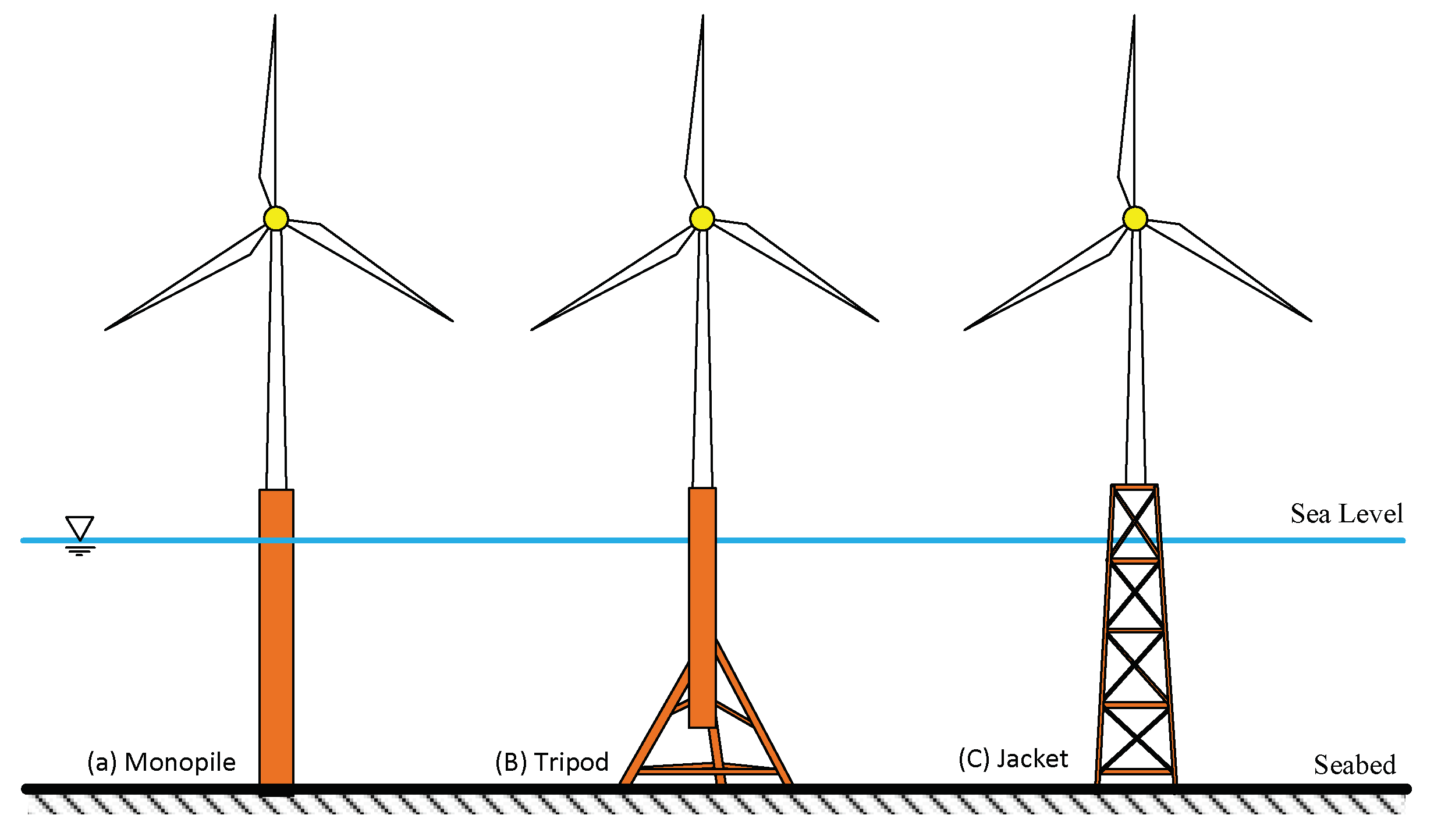
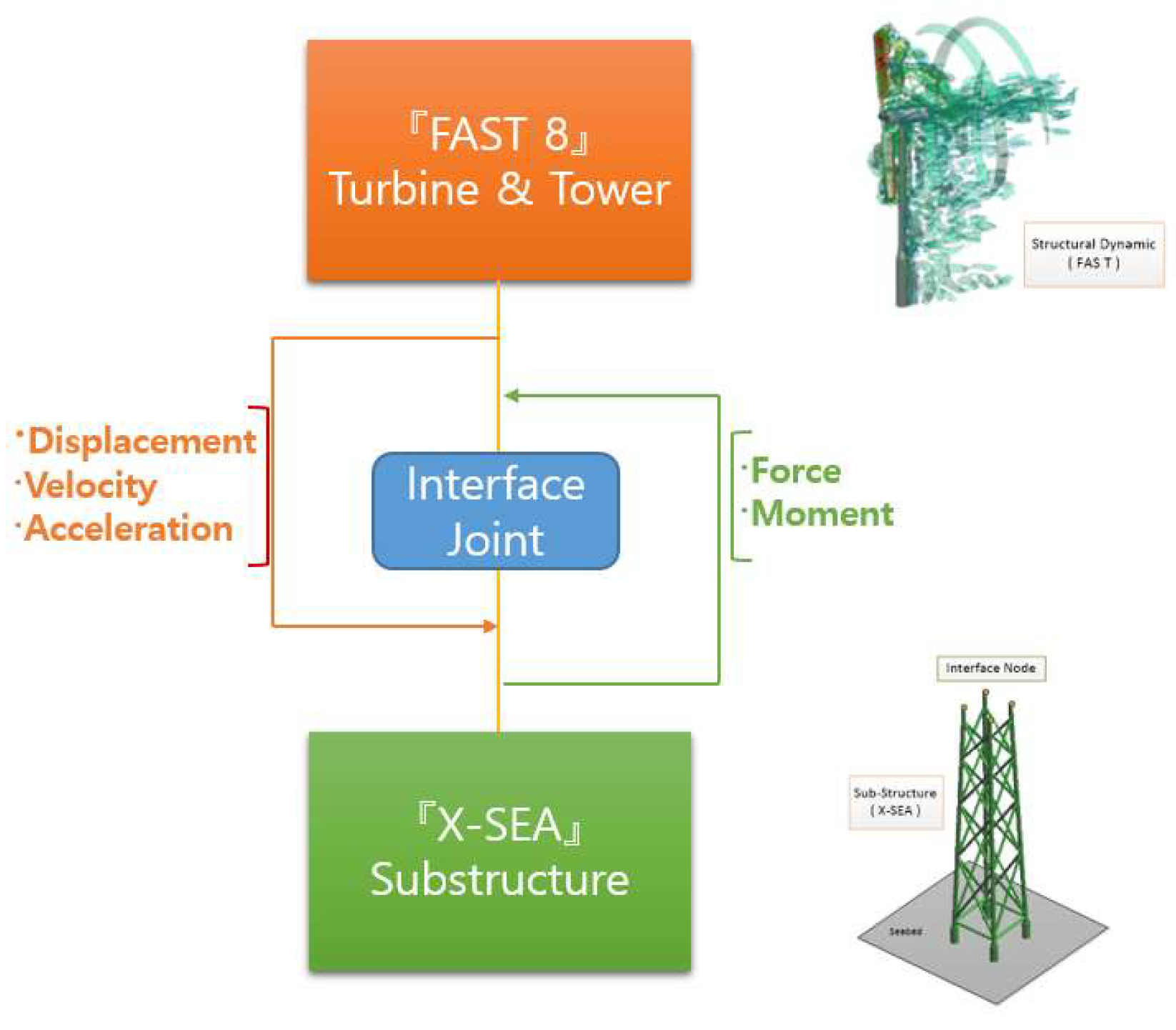
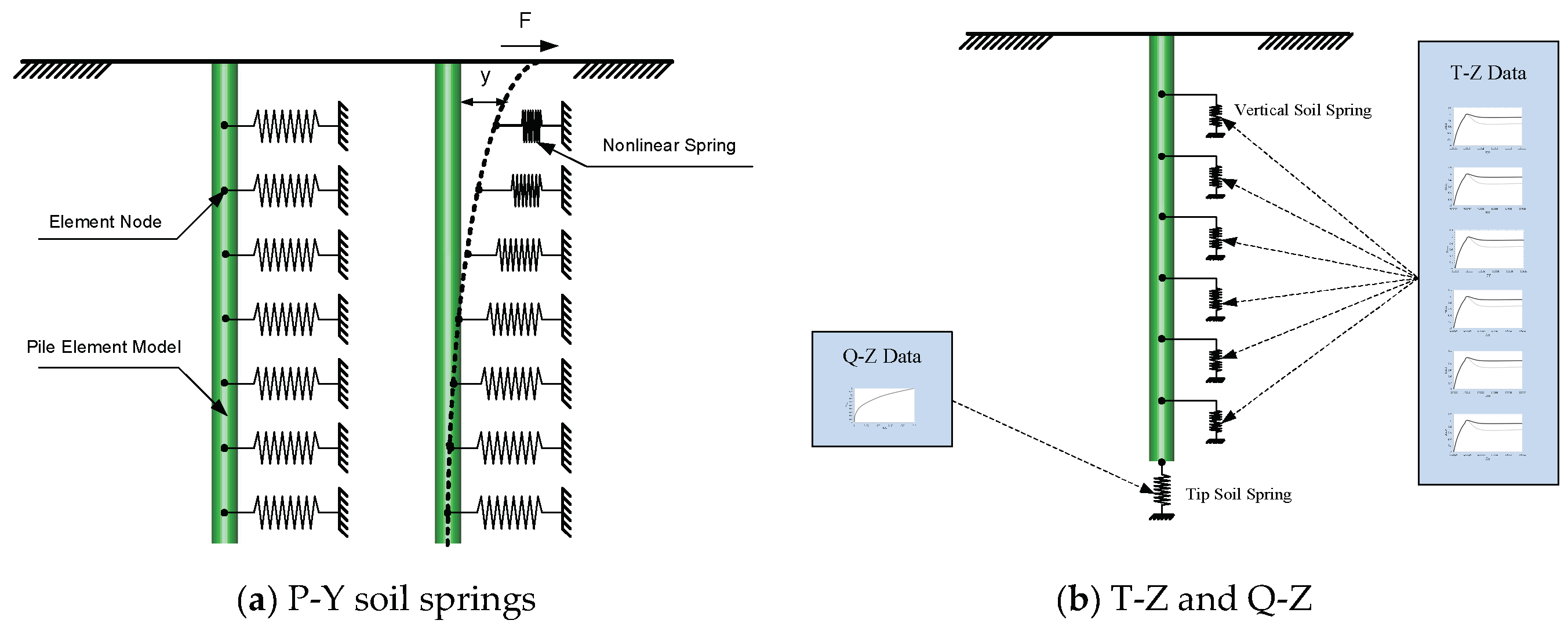
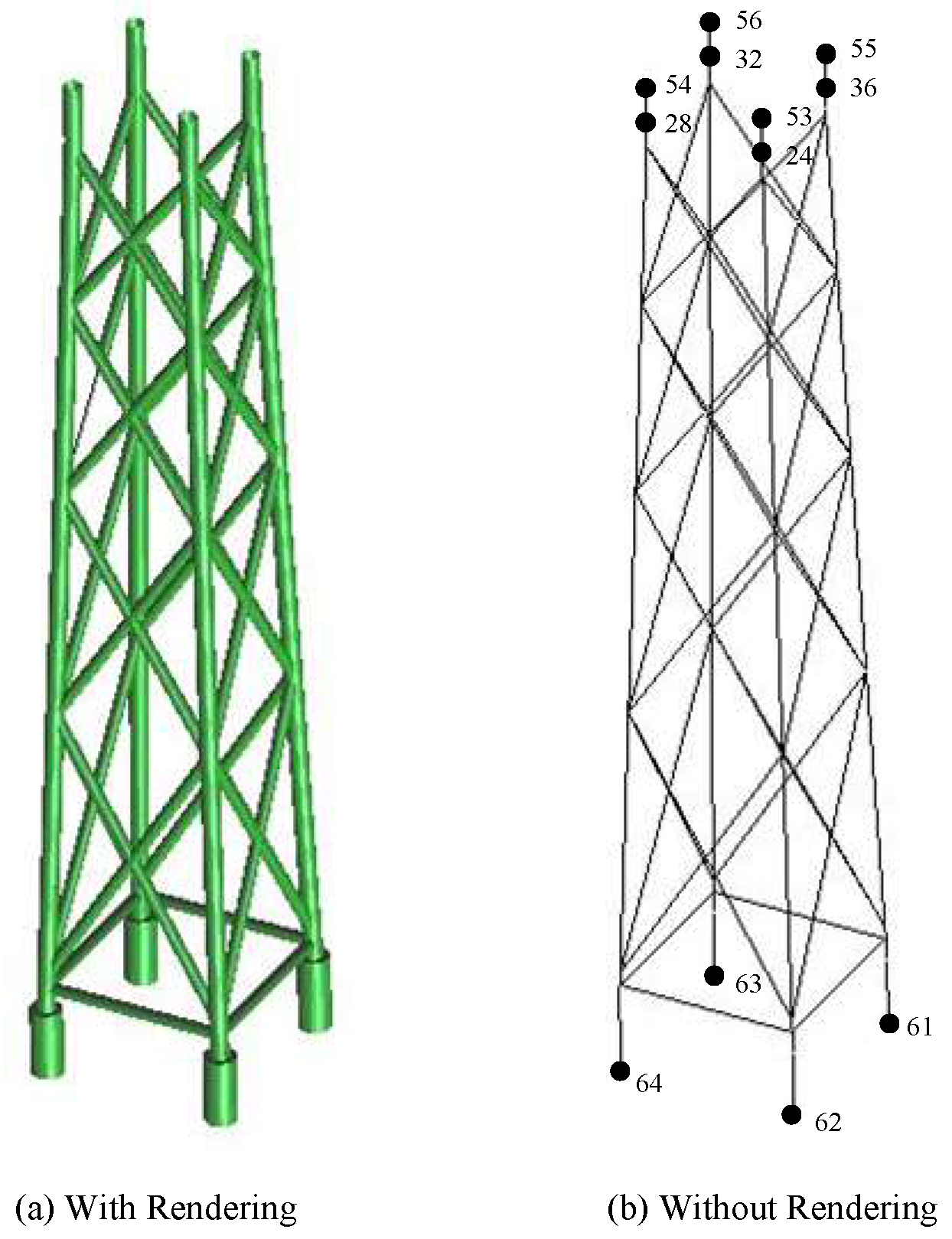
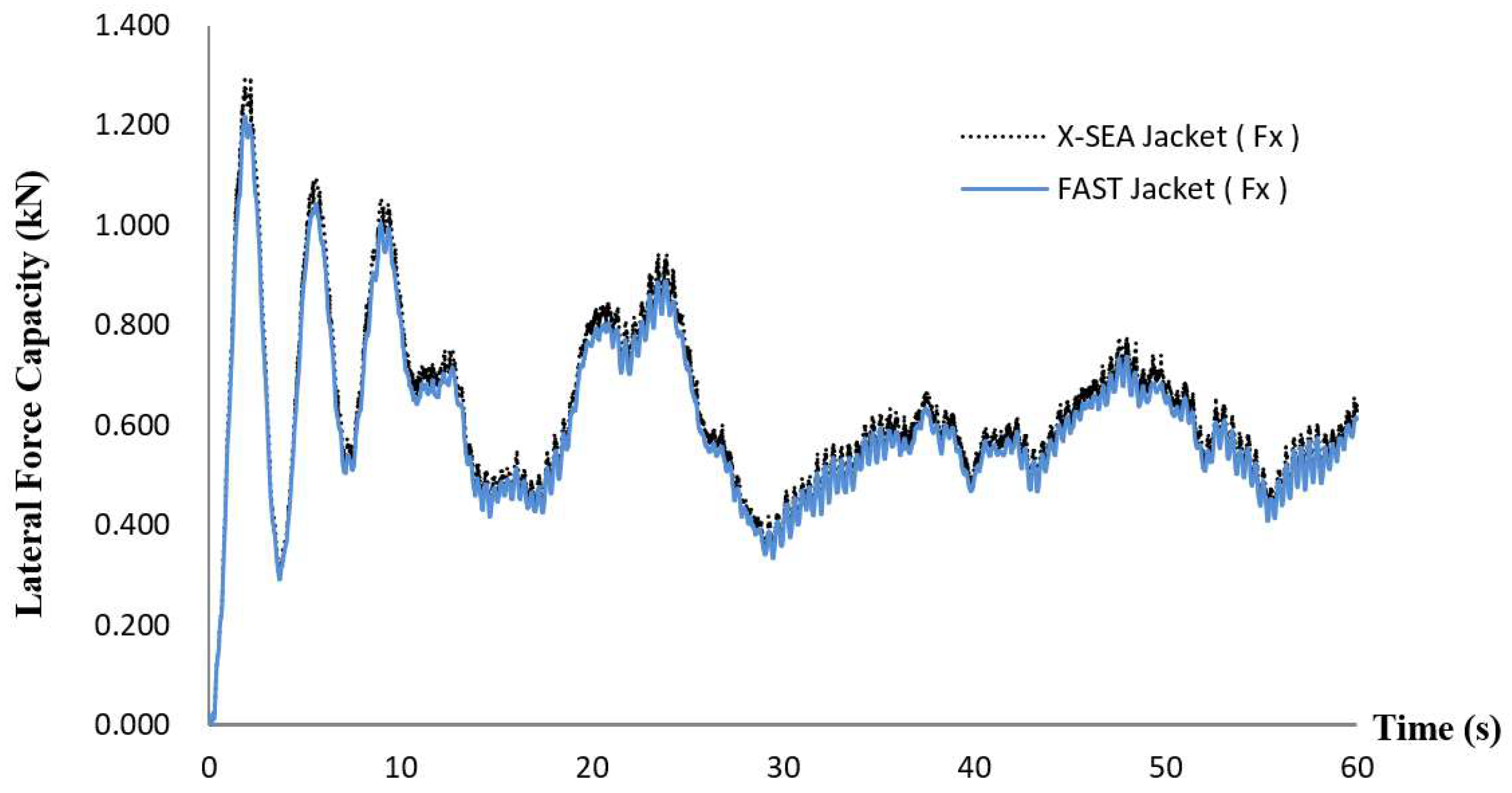
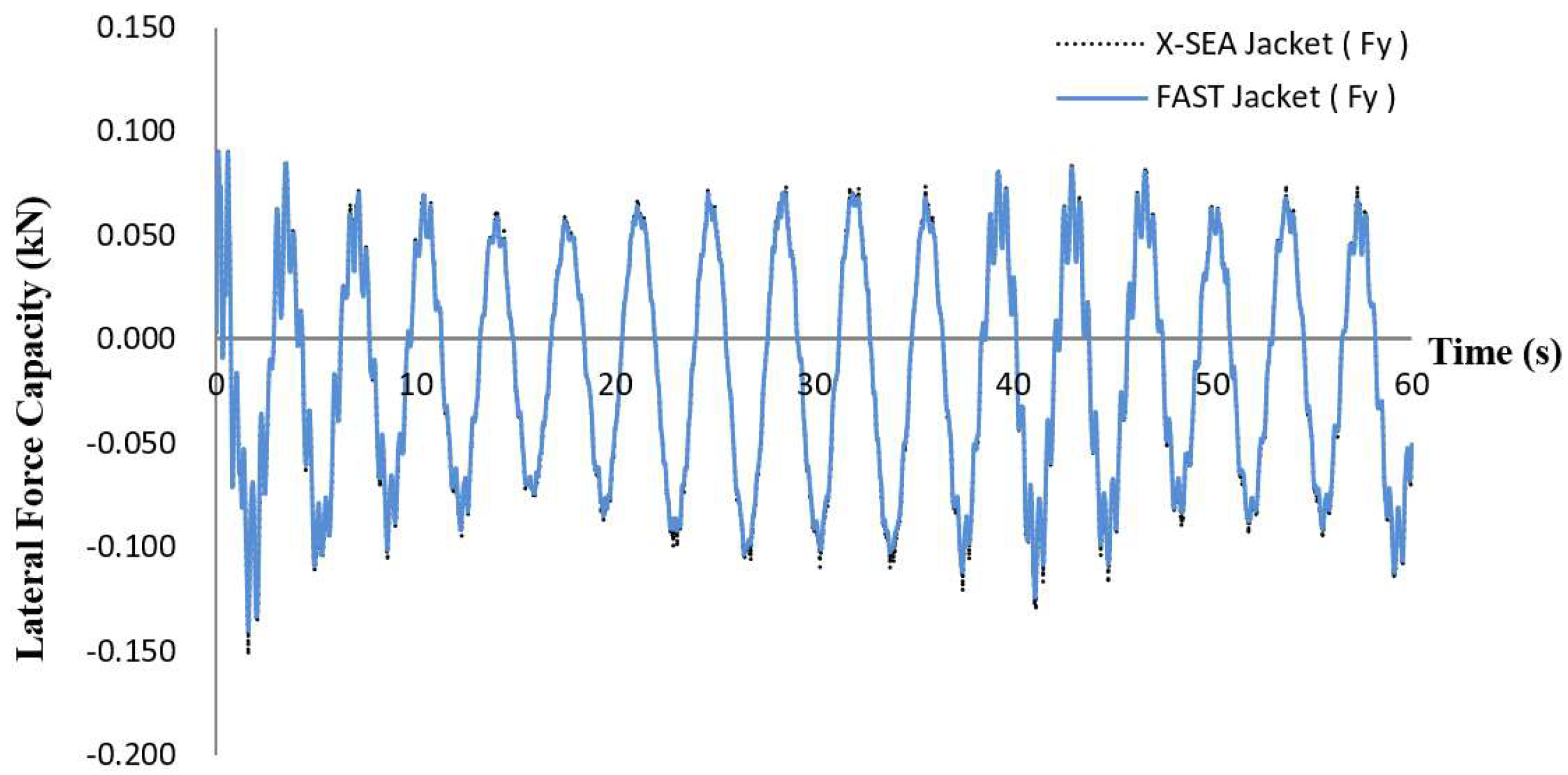
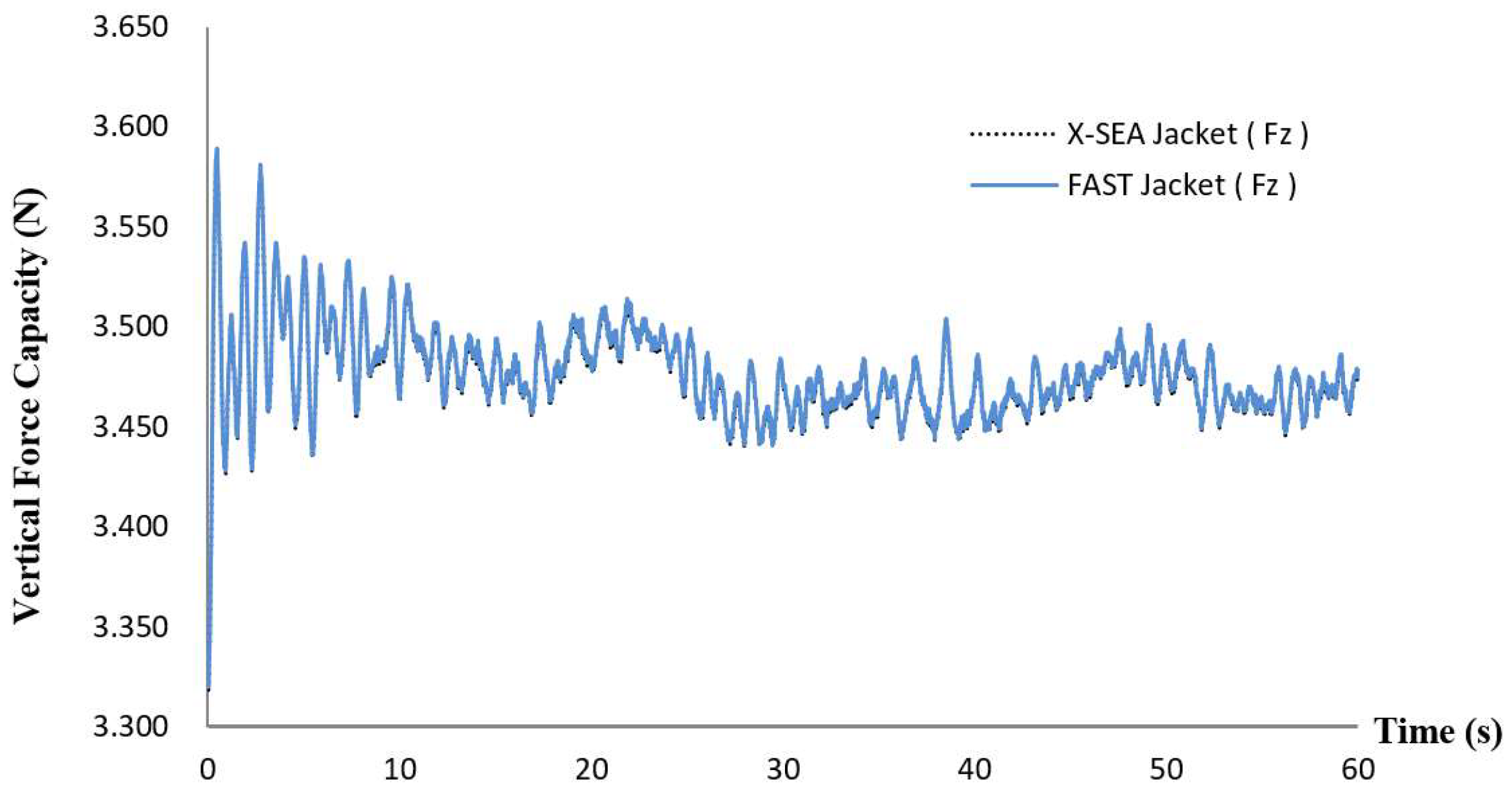
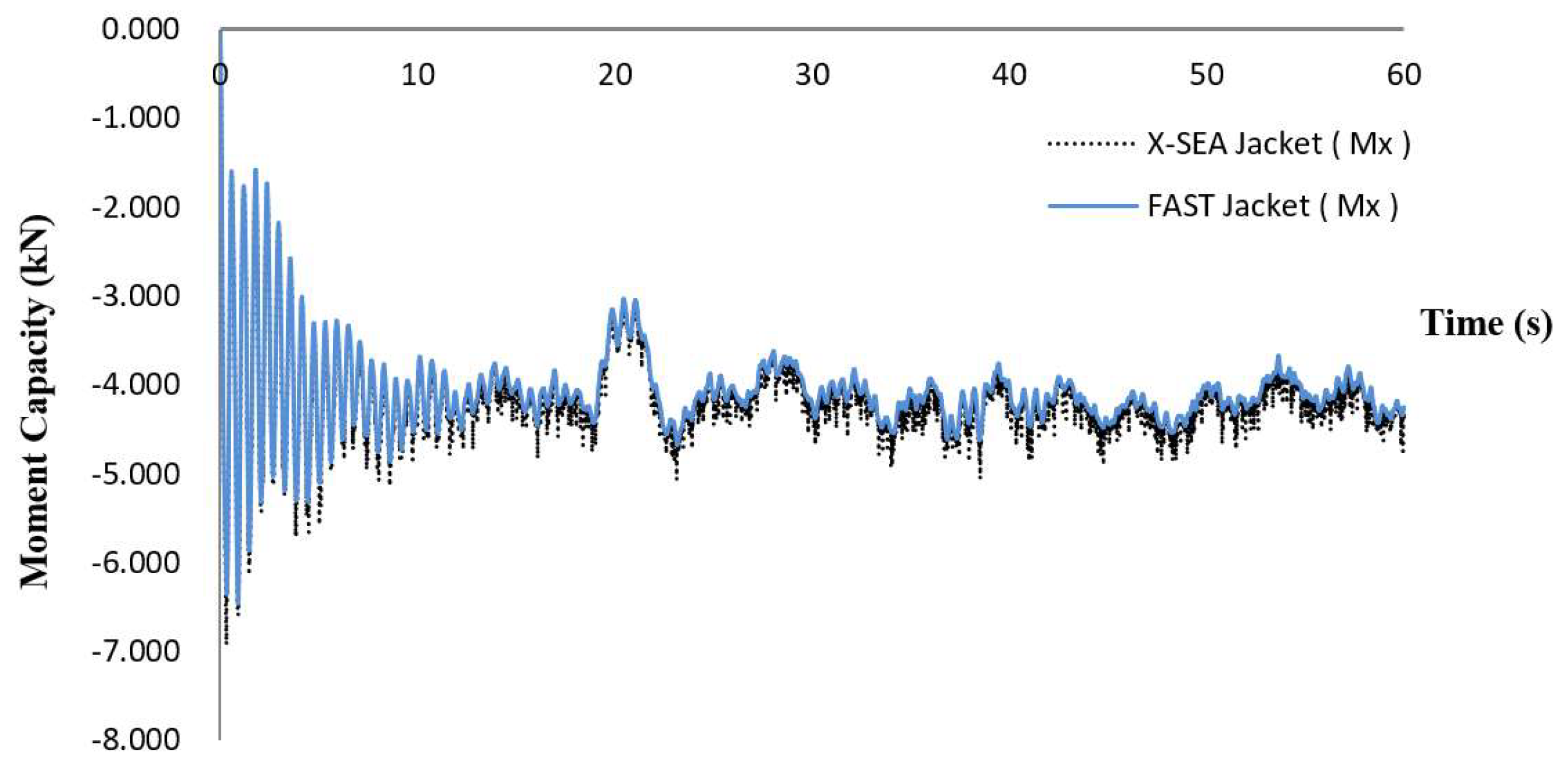
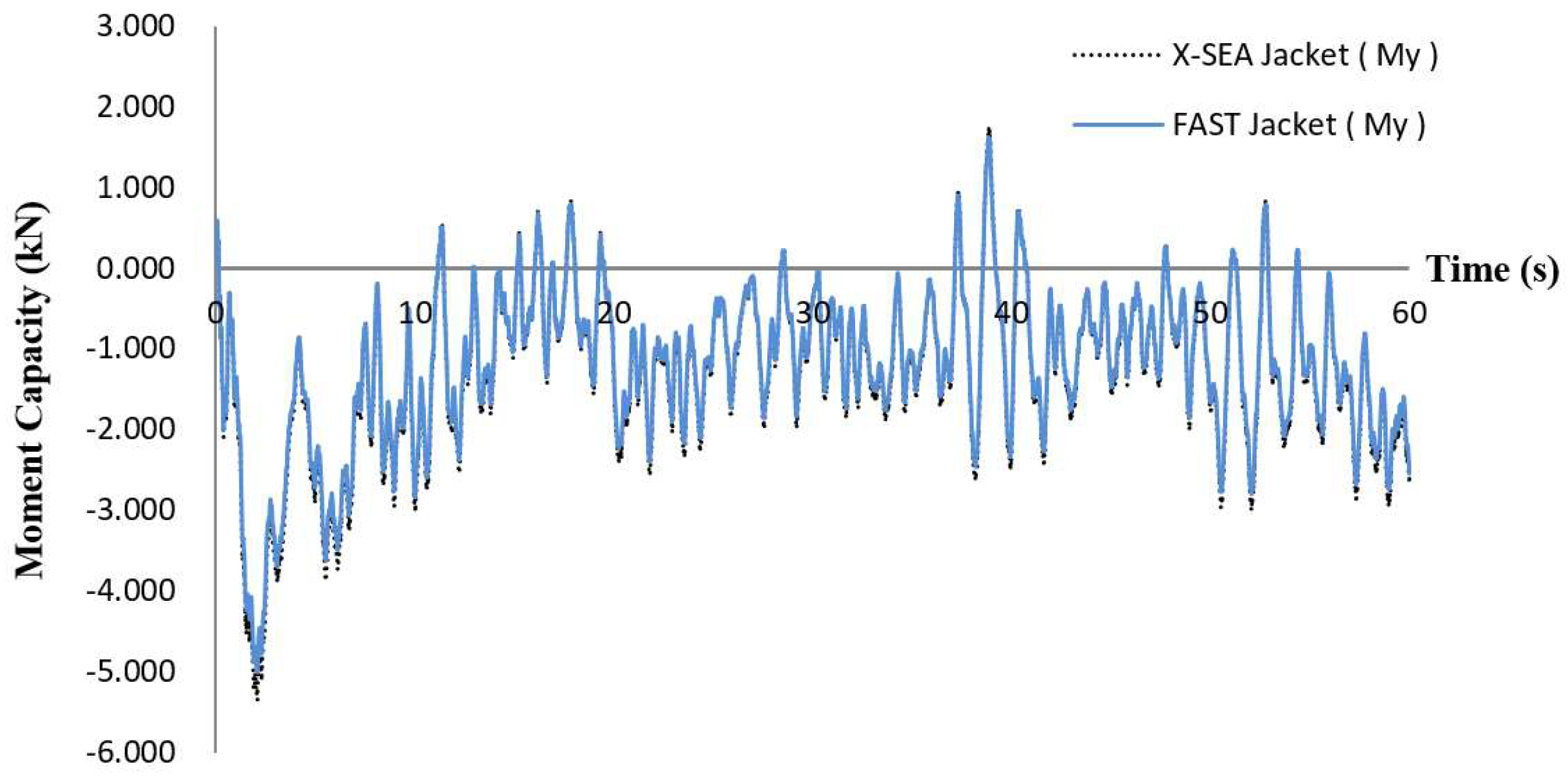
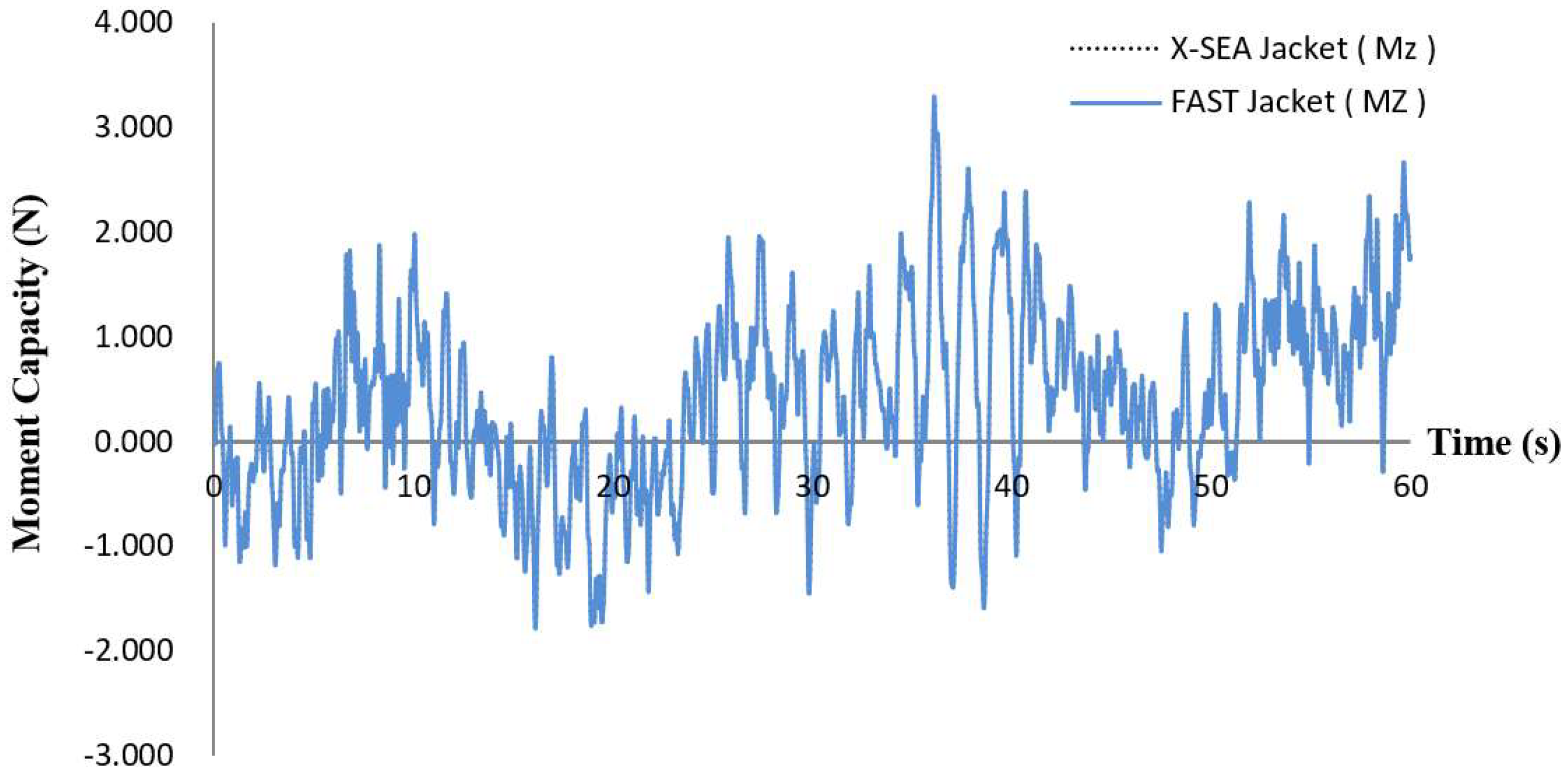
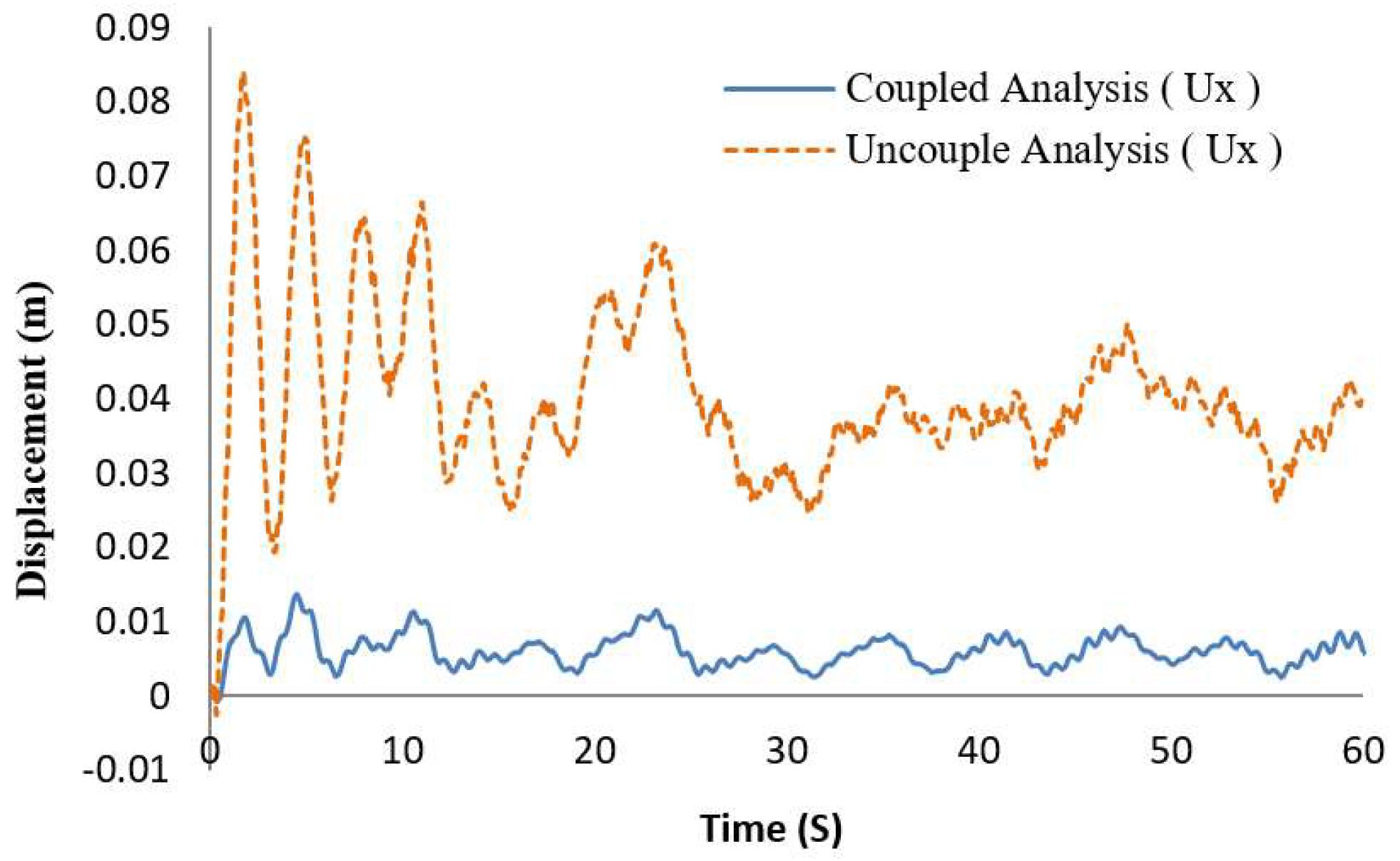
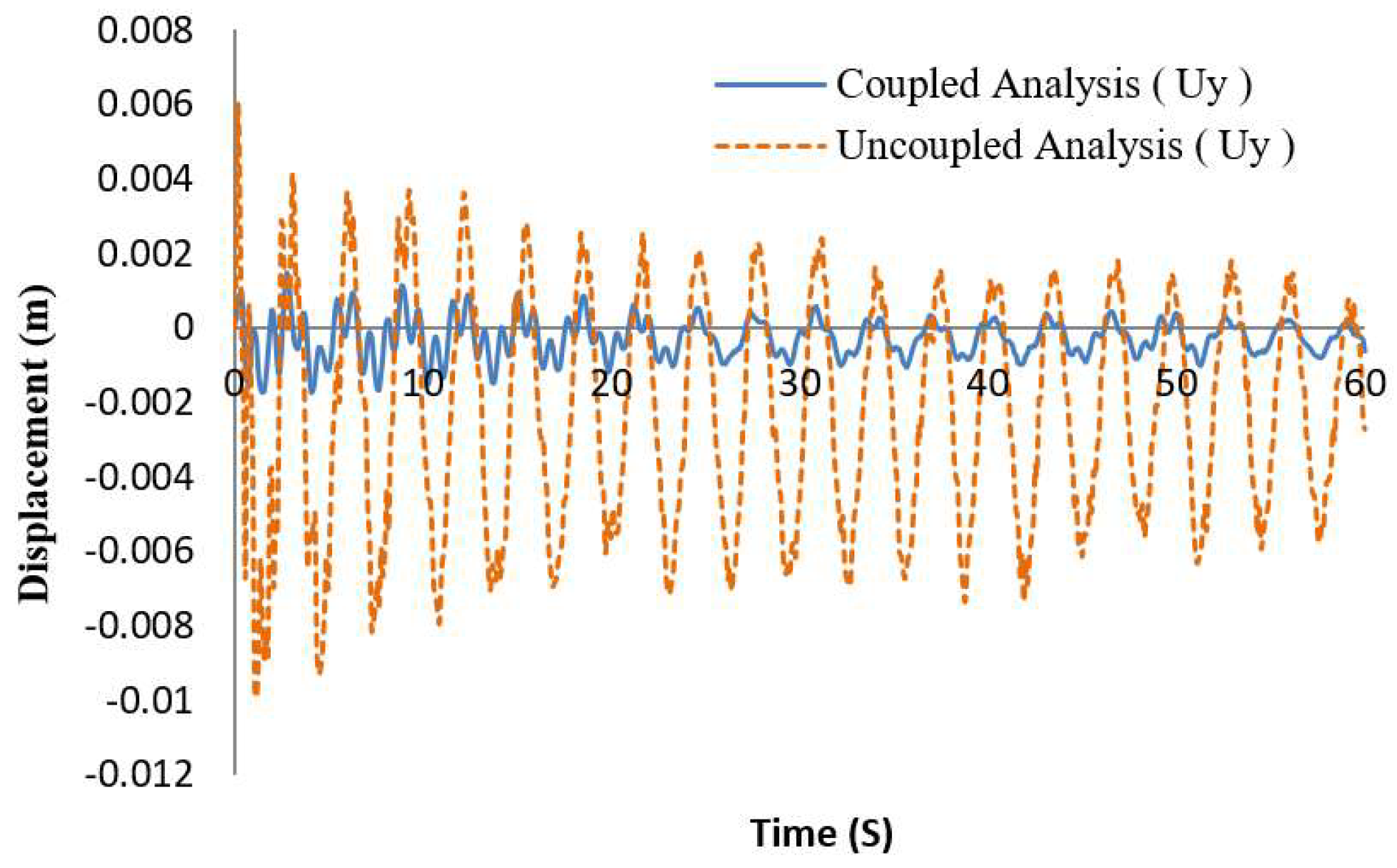
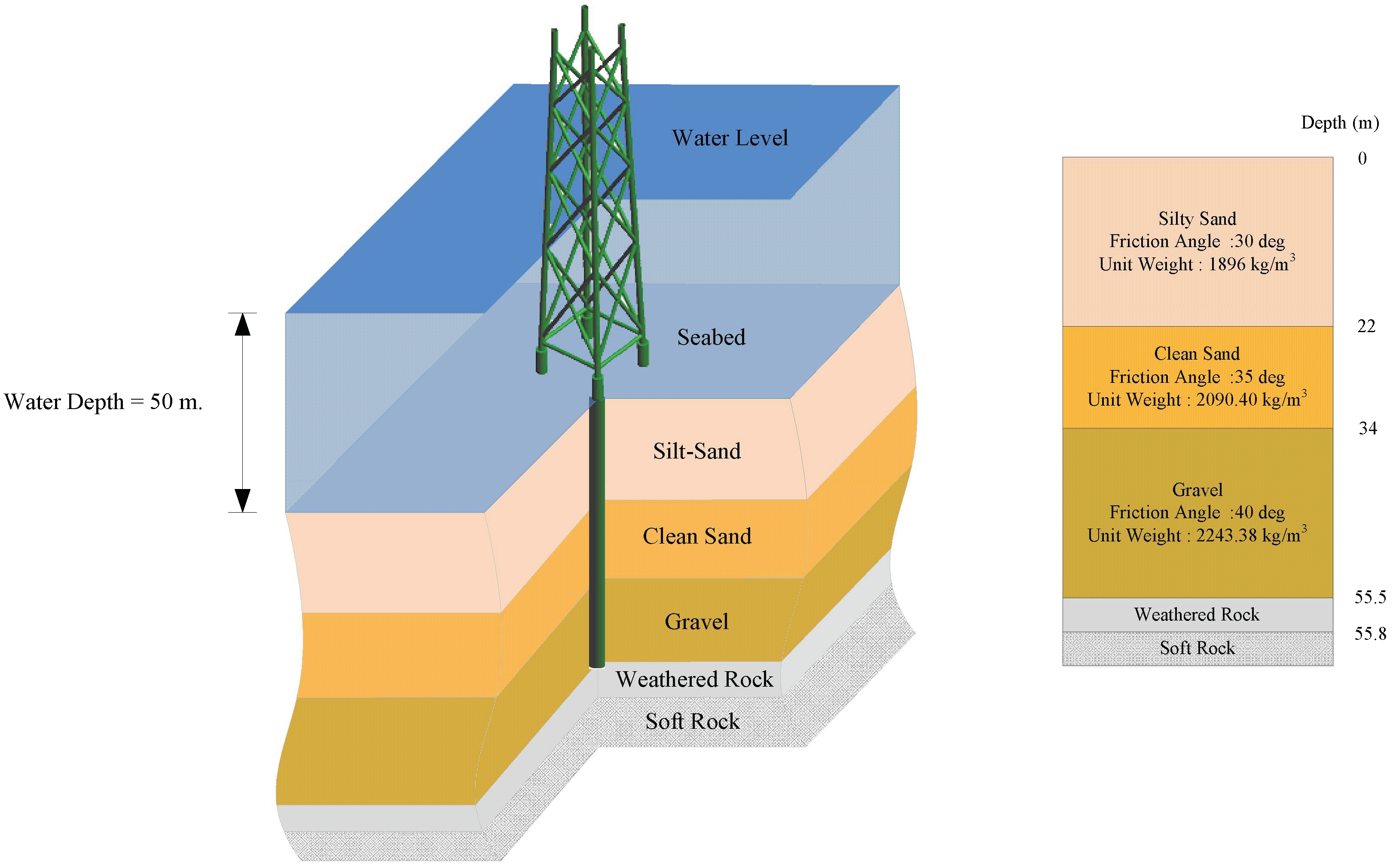
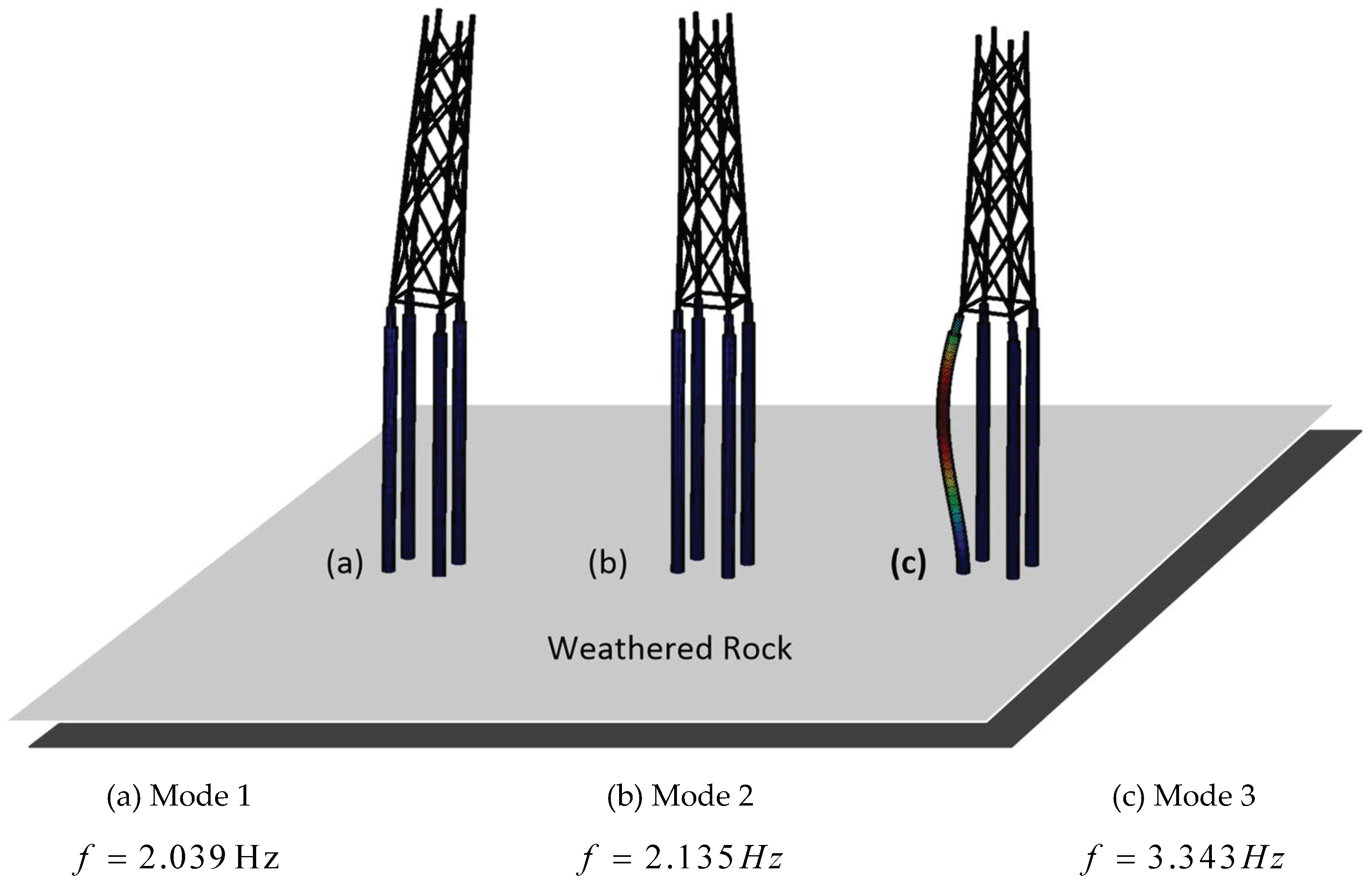
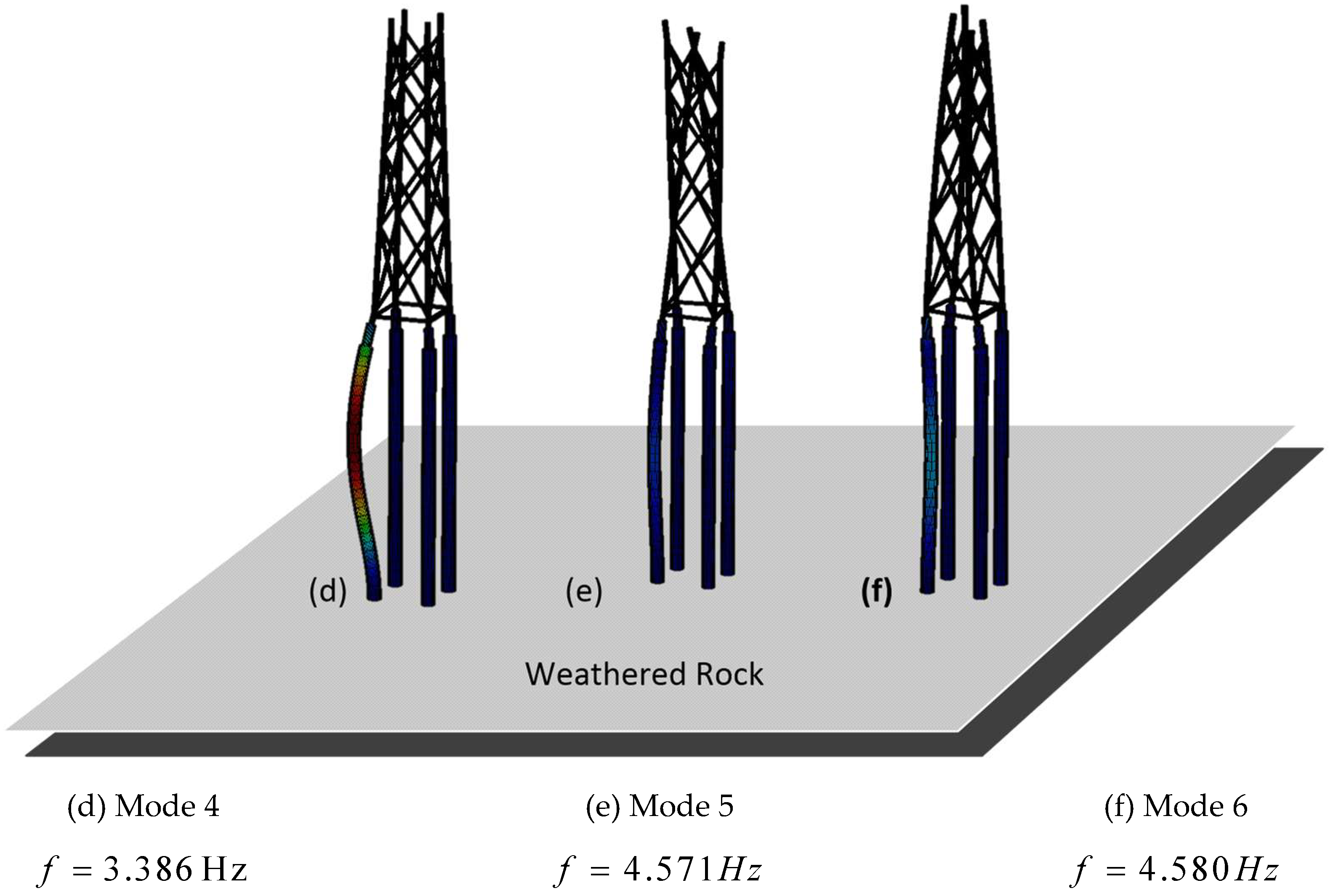
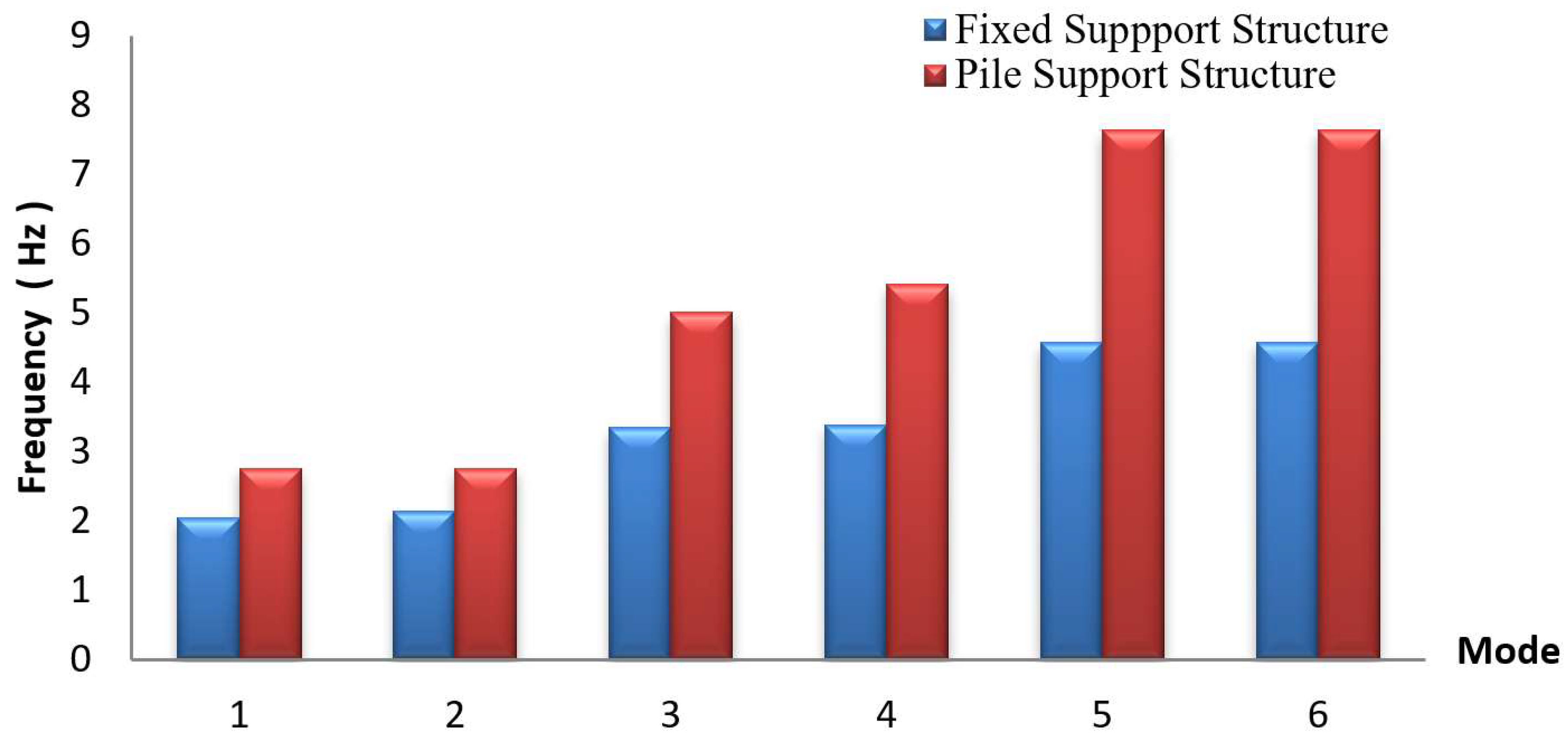
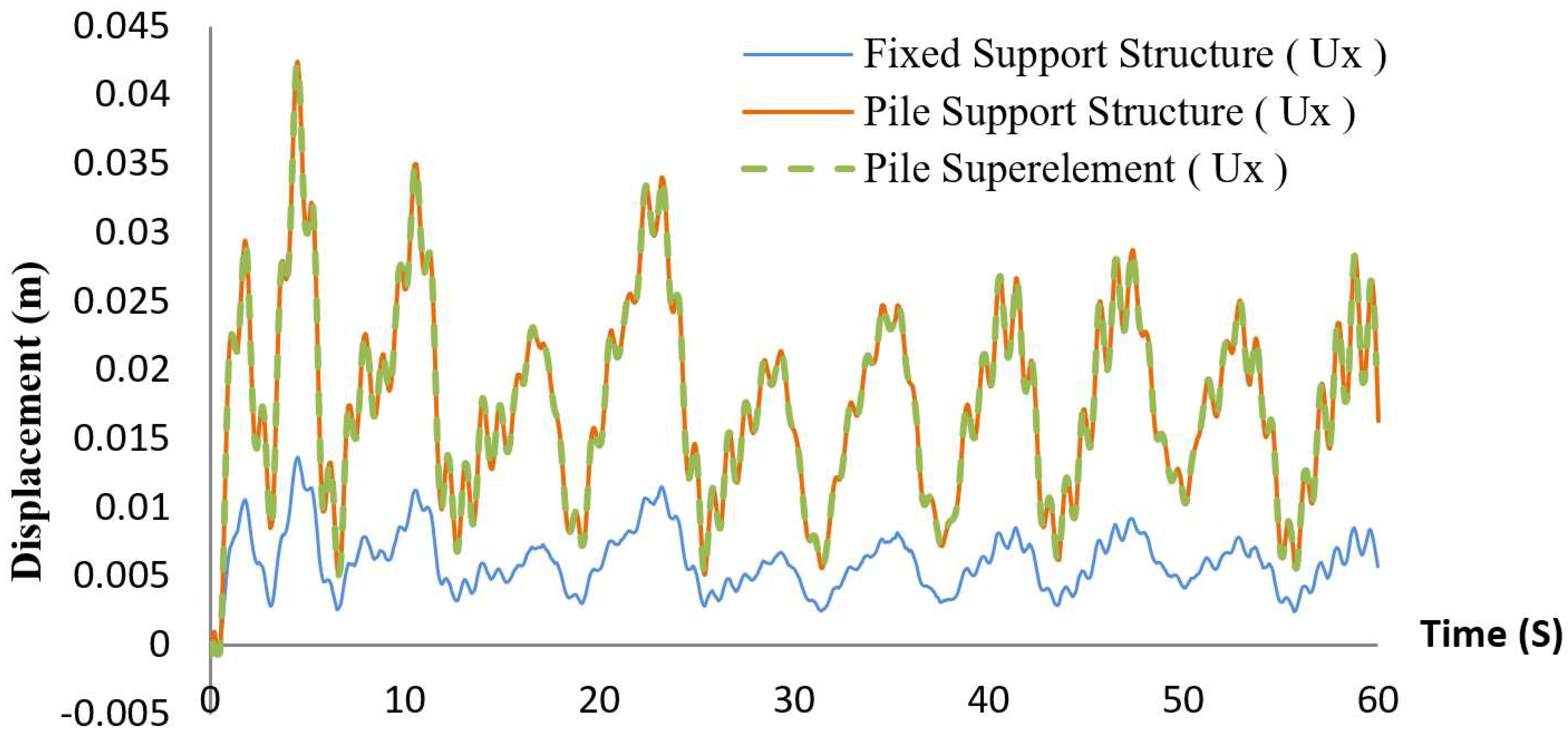
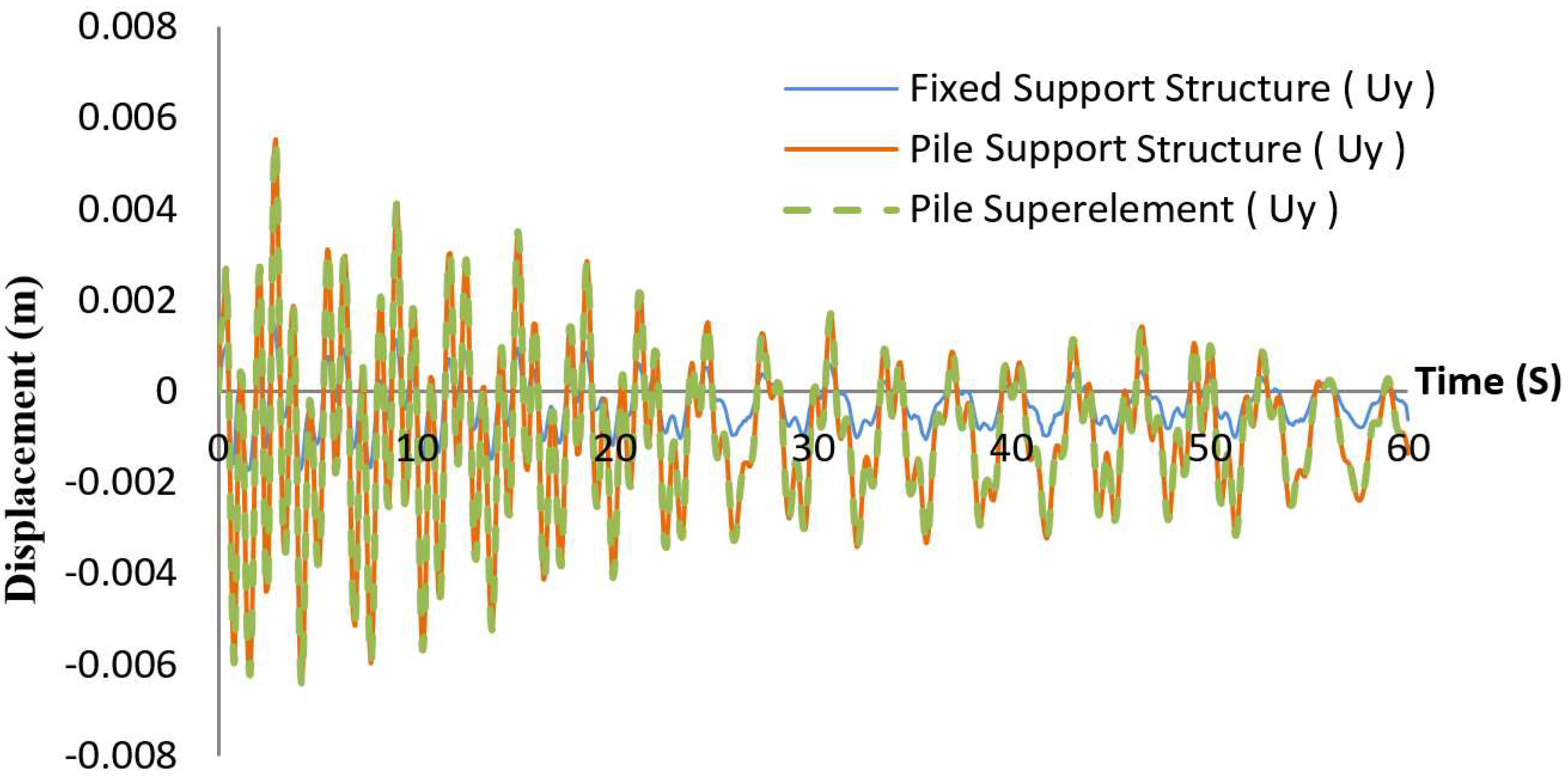
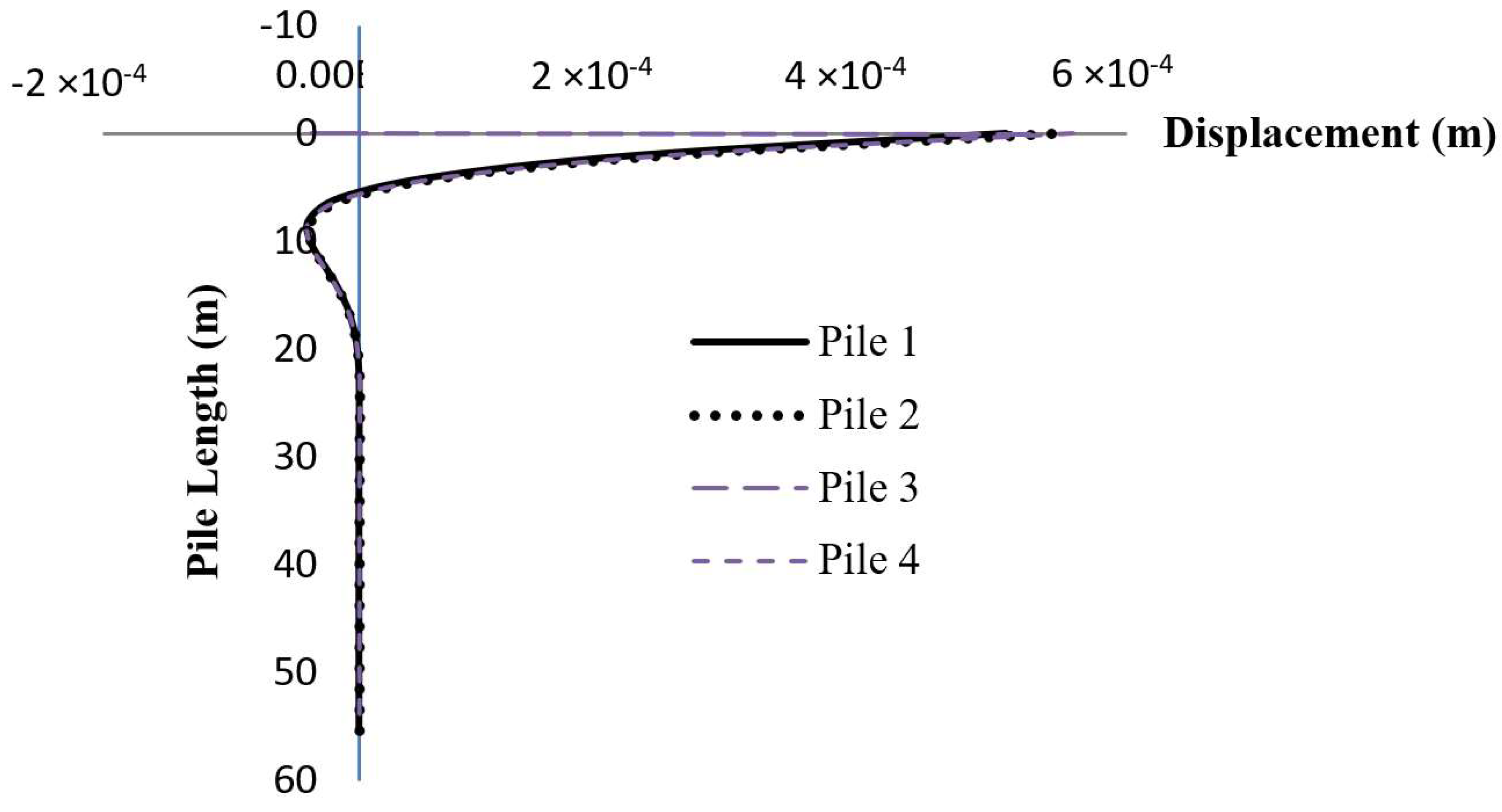
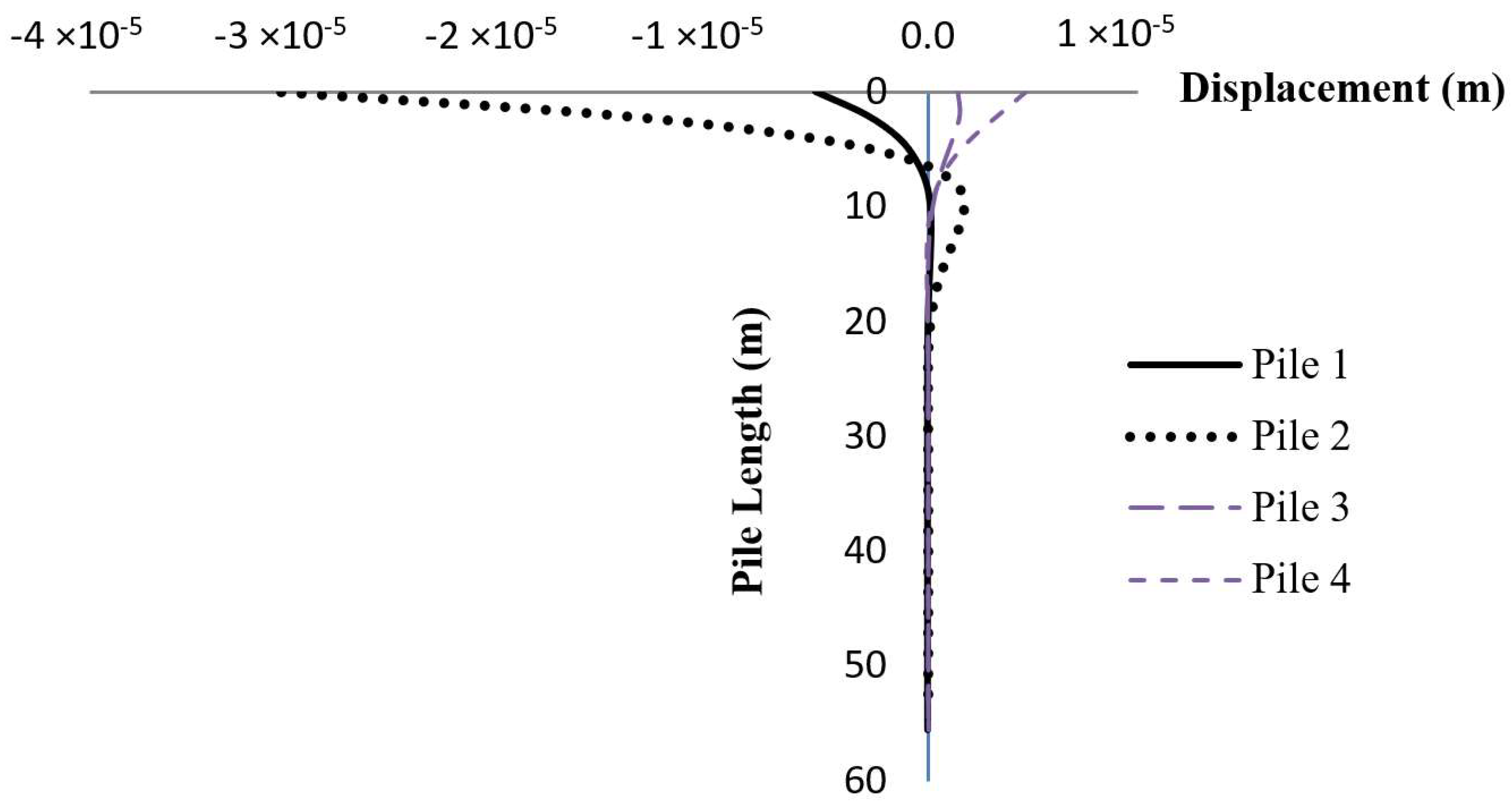
| Solution Features of X-SEA |
|---|
| Environmental load (wave, current, wind, marine growth, buoyancy, earthquake, self-weight etc.) |
| Regular (five kinds) and irregular wave (PM and JONSWAP Spectrum) |
| 3D linear diffraction wave theory (shell and solid element) |
| Static analysis with load combinations |
| Frequency analysis |
| Three-dimensional prestressed concrete analysis using 3D solid and shell element |
| Geometrical and material nonlinear analysis of frame, shell and solid elements |
| Nonlinear time history dynamics (dynamics of large deformation of elastoplastic analysis using frame, shell and solid elements) |
| Pile-soil-interaction foundation analysis (P-Y, T-Z and Q-Z) |
| Dynamic analysis in time domain and frequency domain |
| COG (center of gravity) |
| Automatic calculation of Stress Concentration Factor (SCF) with local joint flexibility |
| Fatigue damage analysis in time and frequency domain |
| Mooring analysis with seabed contact for floating offshore structures |
| Multiple calculation of FAST v8 wind turbine loads |
| Coupled analysis of FAST v8 and offshore structural analysis |
| Code checking (AISC, API, Euro Code 3, Norsok, DNV and IEC wind) |
| Hydrodynamic Analysis | ||
|---|---|---|
| X-SEA Element | Material Property | |
| Shell element | XSHELL3-QSI: 3 node quasi-conforming XSHELL4-ANS: 4 node assume natural strain | Elastoplastic: Von Mises with strain hardening, Ivanov-Yulishin, Concrete elasto-plastic and elasto-plastic fracture, laminate composite, concrete creep |
| Frame element | XFRAME: 2 node frame element with warping (7 dof, shear deformation, tapered, offset) | Elasto-plastic: Von Mises, concrete creep |
| Solid element | XSOLID4T & XSOLID10T: 4 and 10 node, tetrahedral XSOLID8-EAS: EAS 8 node | Elasto-plastic: Von Mises, Mohr-Coulomb, Drucker-Prager, Tresca |
| Truss element | XTRUSS: 2 node three-dimensional element | Elasto-plastic: Von Mises |
| Cable element | XCABLE–Parbolic XCABLE–Catenary XCABLE-Mooring | 5-point nonlinear model |
| Spring element | XSPRING: 3D Spring | |
| Link Element | Gap, hook, gap-hook | |
| Interface element | 1D, 2D, 3D (bond-slip element) | |
| Tendon element | 3D prestressing tendon | |
| Parameter | Value |
|---|---|
| Outer diameter of a leg [m] | 1.200 |
| Wall thickness of a leg [m] | 0.045 |
| Outer diameter of a diagonal [m] | 0.800 |
| Wall thickness of a diagonal [m] | 0.035 |
| Young’s modulus [N/m2] | 2.1 × 1011 |
| Density [kg/m3] | 7850 |
© 2019 by the authors. Licensee MDPI, Basel, Switzerland. This article is an open access article distributed under the terms and conditions of the Creative Commons Attribution (CC BY) license (http://creativecommons.org/licenses/by/4.0/).
Share and Cite
Plodpradit, P.; Dinh, V.N.; Kim, K.-D. Coupled Analysis of Offshore Wind Turbine Jacket Structures with Pile-Soil-Structure Interaction Using FAST v8 and X-SEA. Appl. Sci. 2019, 9, 1633. https://doi.org/10.3390/app9081633
Plodpradit P, Dinh VN, Kim K-D. Coupled Analysis of Offshore Wind Turbine Jacket Structures with Pile-Soil-Structure Interaction Using FAST v8 and X-SEA. Applied Sciences. 2019; 9(8):1633. https://doi.org/10.3390/app9081633
Chicago/Turabian StylePlodpradit, Pasin, Van Nguyen Dinh, and Ki-Du Kim. 2019. "Coupled Analysis of Offshore Wind Turbine Jacket Structures with Pile-Soil-Structure Interaction Using FAST v8 and X-SEA" Applied Sciences 9, no. 8: 1633. https://doi.org/10.3390/app9081633
APA StylePlodpradit, P., Dinh, V. N., & Kim, K.-D. (2019). Coupled Analysis of Offshore Wind Turbine Jacket Structures with Pile-Soil-Structure Interaction Using FAST v8 and X-SEA. Applied Sciences, 9(8), 1633. https://doi.org/10.3390/app9081633







